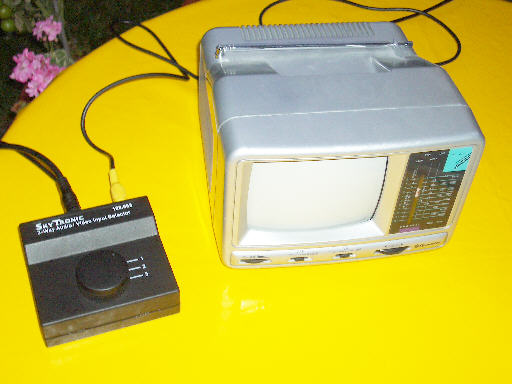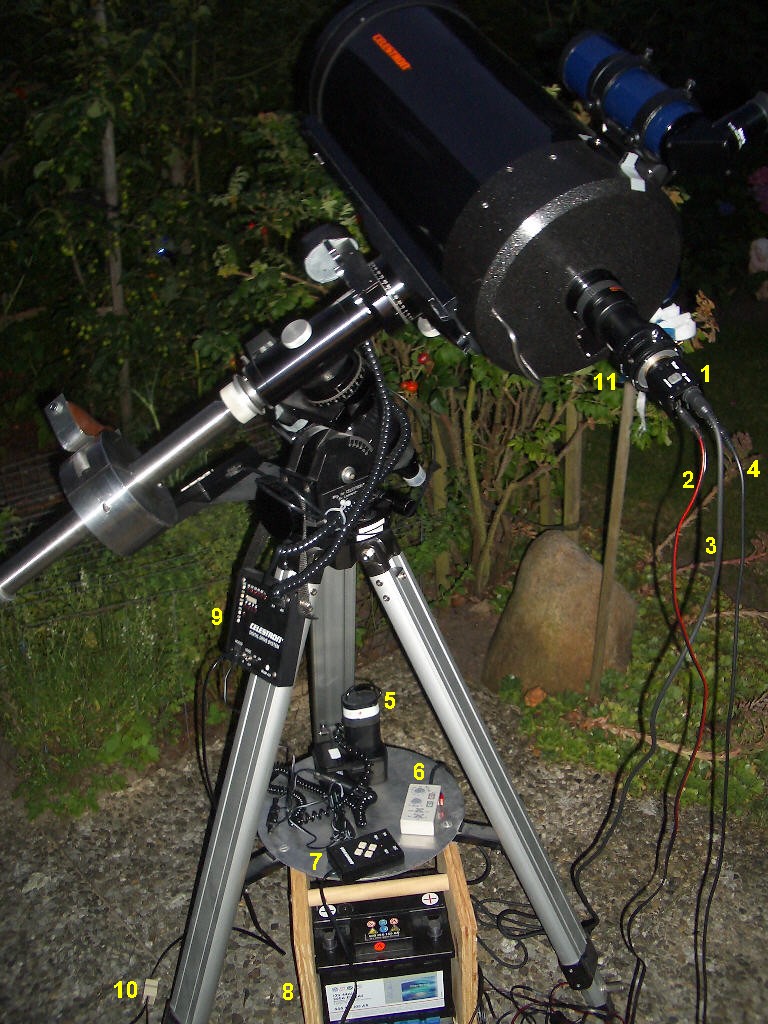Prime focus astrophotography with a CCTV-camera
The picture shows my setup for astrophotographing the night sky. The legend to the numbers is as follows:
1 = CCTV-camera Watec WAT 120-N
2 = 12V power supply cable for the camera, power from battery 8
3 = Cable to hand controller 6
4 = Video cable to switch box (see below) and monitor
5 = 14.4V NiCd-battery (adapter is from an old battery drill) for power supply of telescope
6 = Hand controller for CCTV-camera
7 = Hand controller for manual corrections of telescope in RA and DEC
8 = 12V car battery (in wooden carrying cradle) for power supply of camera
9 = Control panel for telescope
10 = Y-connector to connect two hand controllers for manual corrections parallel to control panel 9. The second hand controller is next to the keyboard of my PC.
11 = Adapter made from a cheap teleconverter lens to connect the CCTV-camera homofocal with my SLR-cameras to the telescope.

For focussing and centering of objects I use a small portable black&white TV set with video input. The TV set can be operated on 8 1.5V batteries, a 12V battery or AC mains. If the video signal of the CCTV-camera is shared by both the TV set and the frame grabber card in the PC then the frame grabber does not get the full signal. That is why I use the switch box.
The switch box can be operated in two modes. In the shown mode the video signal is switched alternatively to the monitor (the cable with the yellow plugs) or to the frame grabber (via the cable to the left). In a second mode it is possible to use a second CCTV-camera at a short focus telescope as a finder. In this case the video signals of the two cameras are switched alternatively to the monitor and the frame grabber. The frame grabber is connected via a Y-connector to the Watec camera. During centering the Monitor and the frame grabber share the video signal but during the exposures the finder camera is switched to the monitor so that the frame grabber gets the full signal strength.
The aluminium disk stabilizes the tripod considerably. But still the tripod is the weak point of the whole setup. The telescope and camera are however not touched during the exposures because once the object is centered everything is controlled done from inside the house sitting in front of the PC. Should wind gusts shake the telescope the few impacted frames can be easily sorted out using the software VirtualDub.
ADDENDUM:
Meanwhile I changed the setup slightly. The 12V car battery is used as the power supply now for both the CCTV-camera and the telescope. This involves less parts and avoids to change the 14.4V batteries every three or four hours.
As long as I use the Advanced Astro Master (seen above the control panel 9 next to the counter weight but not numbered) I do not need a second camera at a kind of finder scope. I just zero-in on the object according to the Astro Master and then center the object remotely in front of my computer via the second hand controller. This is possible because I use print-outs of the relevant regions from the POSS that show not only the object but also the surrounding area up to one square degree. As an alternative source I use images by other astrophotographers from the internet that show the objects plus lots of surrounding sky. That makes it easy to find out where the telescope is pointing to (normally close to the object) and to center and frame the object.
Back
| 

